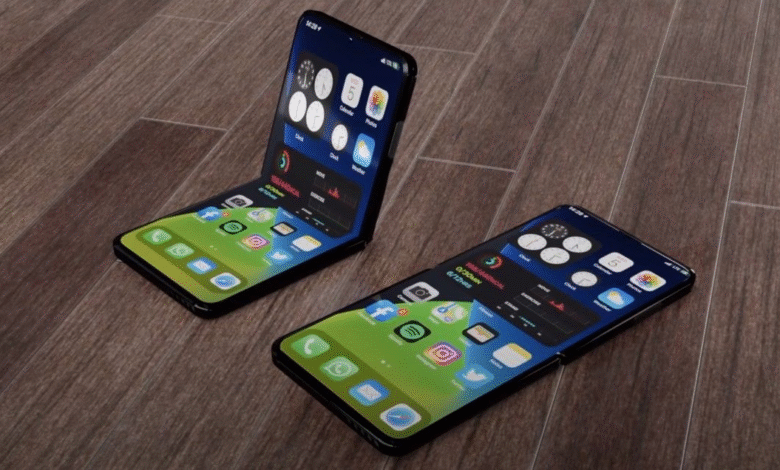Folding iPhones: Apple to Launch Premium Models Next Year

Folding iPhones are set to revolutionize the smartphone market, with Apple planning to introduce these innovative devices next year. According to prominent analyst Ming-Chi Kuo, the upcoming Apple folding iPhone is expected to feature a state-of-the-art display crafted by none other than Samsung Display, which is gearing up to produce millions of foldable panels specifically for this model. This move into foldable smartphones reflects Apple’s commitment to staying competitive in the evolving landscape of premium mobile devices, especially as consumer demand shifts towards versatile and multifunctional gadgets. The anticipated launch is being closely watched, as it may come with a premium price tag, aligning with Apple’s history of delivering high-end technology with stunning new iPhone features. With competitors like Samsung leading the way in foldable technology, Apple’s entry could redefine what users expect from their smartphones.
The next generation of smartphones is on the horizon with the emergence of foldable devices, which are becoming increasingly popular among tech enthusiasts. Analysts suggest that Apple’s forthcoming folding phone will integrate advanced technology provided by leading manufacturers like Samsung, challenging existing models already found in the market. As the competition heats up, companies are vying to capture the attention of consumers looking for the latest in cutting-edge mobile technology. These foldable gadgets promise versatility, allowing for tablet-like experiences while maintaining the convenience of compact devices. With new designs and features continuously surfacing, the evolution of these handhelds is set to change how we interact with our mobile experiences.
The Future of Apple’s Folding iPhones
Apple’s entry into the foldable smartphone market marks a significant shift in its product strategy, as the company seeks to blend cutting-edge design with advanced technology. With the anticipation surrounding the launch of the new folding iPhone, consumers can expect a device that not only features a robust foldable display—potentially manufactured by Samsung Display—but also integrates Apple’s hallmark quality and performance. As Apple continues to innovate, reports suggest that this next-generation iPhone will come with a suite of premium features that could redefine user interaction in mobile devices.
Analyst Ming-Chi Kuo’s insights highlight that the forthcoming folding iPhones are slated for a premium price segment, which aligns with Apple’s strategy of catering to high-end consumers. This move could position Apple more competitively against other foldable offerings in the market, especially considering the rising popularity of foldable smartphones from competitors like Samsung and Huawei. As Apple refines the technology behind its unique folding design, adjusting elements such as the hinge mechanism will be critical to ensure durability and user satisfaction.
Comparing Foldable Smartphones: Apple vs. Competitors
The landscape of foldable smartphones is becoming increasingly crowded, with manufacturers like Huawei and Samsung leading the charge with diverse offerings that have captivated tech enthusiasts. Apple’s anticipated folding iPhone must not only replicate the success of its competitors but also bring something novel to the table. Many foldable devices struggle with hardware issues, such as screen creasing and overall durability. Apple has an opportunity to leverage its expertise in quality control and software optimization to overcome these hurdles and set new industry standards.
As other brands, particularly Samsung, have had more time to refine their foldable designs, Apple needs to ensure that its entry into this market does not merely follow trends but establishes its own unique identity. The introduction of features that enhance the usability of foldable technology—such as seamless multitasking, enhanced app compatibility, and superior camera functionalities—will be crucial for Apple. With an eye on maximizing user experience, the company might also incorporate new functionalities that take full advantage of its iOS ecosystem, setting the folding iPhone apart from Galaxy Z Fold series and Huawei’s Mate X.
The Technology Behind Folding iPhones
One of the most exciting aspects of Apple’s folding iPhone is the anticipated technology behind its design. Apple is reportedly looking to collaborate with Samsung Display, which is gearing up to produce millions of foldable panels. This collaboration not only highlights the significance of quality display technology in the foldable space but also signals Apple’s commitment to delivering an exceptional visual experience. Furthermore, the innovation surrounding the hinge design, which is critical for the phone’s functionality, is still under evaluation, making it a key area of focus for the development team.
Foldable smartphones, including Apple’s future offering, represent a new frontier in mobile technology that straddles the line between smartphone and tablet functionalities. As users demand more versatility and larger screens without sacrificing portability, the complexities of foldable technology, from manufacturing to software integration, become increasingly apparent. The importance of a strong user interface coupled with cutting-edge physical design will be essential in attracting consumers who may still be wary of adopting folding technology.
Challenges Facing the Foldable Smartphone Market
Despite the intrigue surrounding folding smartphones, the market faces several notable challenges that Apple will need to navigate. Consumer demand remains tepid as folding phones have not yet proven their durability over time. Many early adopters report issues with creases and screen damage, which can lead to buyer hesitance. Research from TrendForce indicates a low percentage of overall smartphone sales represented by foldables, reflecting the ongoing skepticism consumers have about investing in this new technology.
Moreover, the industry faces tough competition from traditional smartphones that continue to improve in capability and performance without folding screens. As Apple crafts a strategy for its folding iPhone, it will need to communicate not just the advantages of having a foldable device but also how it provides a better experience compared to conventional smartphones. As conventionally designed smartphones evolve, Apple’s folding iPhone must demonstrate unique value and utility to carve out a niche in a still burgeoning market.
Consumer Expectations for the Next Folding iPhone
As anticipation builds for the launch of the folding iPhone, consumer expectations are at an all-time high. Users are eager to see how Apple will innovate within the foldable smartphone space, especially in terms of integrating advanced technology with user-friendly features. Given Apple’s reputation for superior design and functionality, consumers are looking for a device that seamlessly combines the portability of a smartphone with the expansive display capabilities of a tablet.
Beyond just the hardware, potential buyers are already speculating about the new iPhone features that could accompany a foldable design. Features such as enhanced multitasking capabilities, better app optimization for foldable screens, and potential new camera technologies are all speculated to be on the horizon. By meeting these expectations, Apple can further reinforce its brand loyalty and attract a new demographic that values premium mobile devices with cutting-edge features.
The Role of Pricing in Apple’s Folding iPhone Strategy
Ming-Chi Kuo’s statement about the premium pricing of Apple’s new folding iPhones signifies a deliberate strategy to position these devices within a specific market segment. Although high costs have historically deterred some consumers from adopting new technology, Apple is betting on the allure of innovation and quality to justify the price. The emphasis on premium pricing may attract tech enthusiasts and loyal Apple users willing to invest in a device that promises novel capabilities.
This strategic pricing might also allow Apple to maintain its reputation as a luxury brand in the technology sector. While competitors offer foldable smartphones at various price points, Apple may choose to focus on delivering a superior user experience that reflects the value of its premium pricing. This could set the stage for a successful launch, contingent on demonstrating that the folding iPhone is not just a novelty, but a practical device that enhances everyday mobile experiences.
Innovative Features Expected in Apple’s Folding iPhone
As Apple ventures into the folding smartphone market, speculation about innovative features is rampant among tech enthusiasts and consumers alike. The company is known for introducing cutting-edge technologies with each iPhone iteration, and the folding iPhone may not be an exception. Anticipated features include advanced multitasking capabilities that take full advantage of the foldable screen, compelling updates to camera features, and unique applications designed specifically for a foldable format.
In addition to core functionalities, there are expectations for new software integrations that could redefine how users interact with their devices. The opening of a new ecosystem tailored to foldable technology could include features such as enhanced gesture controls and user interfaces specifically designed for the unique screen layout. By marrying hardware advancements with exciting software innovations, Apple can solidify its place as a leader in the evolving smartphone landscape.
The Impact of Samsung Display on Apple’s Foldable Plans
The decision to partner with Samsung Display for the manufacturing of foldable panels is a strategic move for Apple. Samsung has already established itself as a leader in display technology, and leveraging their expertise can provide Apple with a competitive edge in the foldable smartphone market. As they prepare to produce up to eight million panels for Apple, these collaborations signify a commitment to high-quality displays that will enhance user experiences on the new folding iPhone.
Moreover, this partnership highlights the critical role of display technology in the success of foldable devices. Samsung’s advancements in flexible OLED technology can lead to more durable and visually striking screens, addressing many consumer concerns about foldable devices. As Apple integrates this technology into its devices, expectations for the visual quality of their foldable smartphones will be elevated, potentially attracting consumers who may have hesitated to adopt foldable technology.
Apple’s Competitive Position in the Foldable Smartphone Space
Entering the foldable smartphone market allows Apple to diversify its product offerings and strengthen its competitive position against brands like Samsung and Huawei, which have already made significant inroads in this niche. By releasing a folding iPhone, Apple not only appeals to the user base that desires cutting-edge technology but also reinforces its reputation for innovation and quality. This strategic move could lead to increased market share, especially among consumers looking for premium mobile devices with the latest features.
However, Apple must ensure that its entry into the foldable space is met with a product that stands out in terms of functionality and user experience. Competing effectively involves not just providing a folding mechanism but also offering unique advantages that are difficult for competitors to imitate. As Apple prepares to launch its folding iPhone, capturing the excitement of the consumer base and ensuring top-notch quality will be crucial for establishing a foothold in this rapidly evolving market.
Frequently Asked Questions
What are the expected features of the upcoming Apple folding iPhone?
The upcoming Apple folding iPhone is expected to feature a display manufactured by Samsung Display, potentially including innovative technologies that enhance user experience. The device is likely to come with premium pricing, aligning with Apple’s strategy for high-end mobile devices. Analysts suggest that it may sport a unique hinge design, although final decisions on components are still pending.
How will the pricing of Apple’s folding iPhone compare to existing premium mobile devices?
Apple’s folding iPhone is anticipated to carry a premium price tag, similar to other high-end smartphones in its lineup. Analysts predict that the advanced features and Samsung Display foldable technology will justify the higher cost, aimed at attracting customers seeking cutting-edge mobile experiences.
When is Apple expected to launch its folding iPhone?
Analysts, including Ming-Chi Kuo, have indicated that Apple plans to launch its folding iPhone as early as next year. This rollout may set the stage for Apple to enter the foldable smartphone market, which has been dominated by competitors such as Samsung since 2019.
What are the challenges facing folding smartphones like Apple’s?
Folding smartphones, including Apple’s upcoming model, face several challenges. These include potential hardware issues like screen creases at fold points and the need for durable designs. Additionally, market trends show that consumer demand for foldable devices has not surged, which could impact adoption rates.
How does the market for foldable smartphones look compared to traditional smartphones?
The market for foldable smartphones, including the anticipated Apple folding iPhone, remains relatively small, making up only about 1.5% of total smartphone sales. Growth in this segment has stagnated recently, with projections indicating a potential decline in demand, as users may prefer traditional models over foldables.
What makes the Samsung Display technology significant for the Apple folding iPhone?
Samsung Display’s technology is significant for the Apple folding iPhone because it could provide the innovative display capabilities essential for a successful foldable device. With plans to manufacture up to eight million foldable panels, Samsung’s expertise may help Apple overcome existing challenges in foldable smartphone production.
Will the Apple folding iPhone support new features compared to previous models?
While specific features of the Apple folding iPhone have not been disclosed, it is expected to incorporate new functionalities that leverage its foldable design, enhancing productivity and multitasking. This aligns with Apple’s history of innovative offerings in its premium devices.
Are competitors influencing the development of the Apple folding iPhone?
Yes, competitors like Samsung and Huawei, who have been in the foldable smartphone market since 2019, are influencing Apple’s development strategies. Apple observes these competitors’ designs and market performance, which could shape the features and functionalities of its folding iPhone.
| Key Point | Details |
|---|---|
| Folding iPhone Launch | Apple plans to produce a folding iPhone next year. |
| Display Production | Samsung Display is set to manufacture up to 8 million foldable panels for the iPhone. |
| Component Finalization | Final components, including the device’s hinge, are not yet finalized. |
| Pricing Expectation | Analyst Kuo expects it will be priced at a premium. |
| Market Competition | Competitors like Huawei and Samsung already have folding phones available since 2019. |
| Market Demand | Folding phone sales are low and projected to decline in 2025. |
| Analyst Information | Ming-Chi Kuo is a reliable analyst covering Apple’s supply chain. |
Summary
Folding iPhones are set to enter the market as Apple plans their launch for next year, bringing a premium option for consumers. The anticipated device will feature a Samsung-manufactured display, emphasizing innovation in Apple’s product line. However, challenges remain, such as the finalization of key components and potential market demand for folding technology. As competitors like Huawei and Samsung have already explored this innovative concept, Apple must address current hardware challenges to successfully attract iPhone users to this new form factor.




